Bibliometric Examination of Global Scientific Research about Carbapenem-Resistant Acinetobacter Baumannii (CRAB)
Abstract
:1. Introduction
2. Materials and Methods
2.1. Data Collection
2.2. Inclusion and Exclusion Criteria
2.3. Data Extraction
2.4. Bibliometric Analysis
- Publication Trends and Growth: We examined yearly publication trends to discern the evolution of CRAB research over time. Growth rates were calculated and periods of significant expansion were pinpointed [10].
- Authorship and Collaboration: Key contributors and research collectives were identified, with a focus on author collaborations. Collaborative networks were visualized to underscore the relationships between authors and institutions [15].
- Citation Analysis: Citation patterns were meticulously analyzed to unearth highly cited works, influential authors, and seminal contributions that have shaped CRAB discourse [11].
- Keyword Analysis: We conducted an in-depth keyword analysis to spotlight predominant themes and research domains within the CRAB literature. Visualizing co-occurring keywords illuminated thematic connections [16].
- Journal Analysis: The distribution of publications across diverse journals was meticulously scrutinized, bringing to light the prominent publication outlets for CRAB research [17].
- Thematic mapping: Thematic mapping within the realm of bibliometric analysis represents a systematic method for visually comprehending the research terrain of a particular field or subject area. It entails the recognition of fundamental themes, subjects, or research groupings embedded in a corpus of scholarly publications. This systematic approach empowers researchers to delve into and classify the content of these publications, thereby simplifying the process of identifying trends, research trajectories, and the progression of knowledge within the specific domain [18].
3. Results and Discussion
3.1. Yearly Published Articles in Bibliometric Analysis
3.2. Publication Analysis Based on Geographic Distribution
3.3. Bibliometric Analysis of Co-Authorship
3.4. Bibliometric Analysis of Keyword Co-Occurrence
3.5. Bibliometric Analysis of Citations
3.6. Theme Terms and Trend Topic Analysis
- (a)
- Motor Themes (First Quadrant, Top Right): These clusters exhibit high centrality and density, indicating that they are well established and pivotal in shaping the research domain. The cluster highlighted in red within the motor theme comprises terms such as “humans”, “microbial sensitivity”, “antibacterial agents”, and “multi-drug resistance pathogens”. This underscores that the predominant research focus in the CRAB research field revolves around these key concepts.
- (b)
- Niche Themes (Second Quadrant, Top Left): These themes demonstrate high density but low centrality, suggesting that they are of limited relevance and may pertain to specialized or less prominent aspects. The cluster in green within the niche theme encompasses terms such as “molecular kinetics” and “protein conformations”, which have relatively restricted relevance to our research topic.
- (c)
- Emerging or Declining Themes (Third Quadrant, Bottom Left): Clusters located in this quadrant possess low centrality and density, indicating that they are either in their early stages of development or diminishing in importance. The orange cluster within the emerging/declining theme includes terms such as “carbapenem metabolism”, “amino acid sequence”, and “beta-lactamase”. This signifies that certain terms, such as “beta-lactamase”, warrant greater attention, whereas others, such as “amino acid sequences of carbapenemase enzyme”, are in the nascent stages of research within the CRAB research field. Additionally, the second cluster in purple, situated along the central line, exhibits a high degree of relevance. It encompasses terms such as “imipenem”, “meropenem”, “drug resistance”, and “Acinetobacter infections”, which are at the core of our research focus within the CRAB research domain.
- (d)
- Basic Themes (Fourth Quadrant, Bottom Right): These themes possess high centrality but low density. They are crucial for addressing transdisciplinary research issues. The blue cluster contains terms such as “intensive care unit”, “antibacterial drug effects”, and “middle-aged” that are primarily centered on research concerning the precautions and measures required in cases of CRAB infection.
4. Future Perspective
5. Limitations
6. Conclusions
Author Contributions
Funding
Institutional Review Board Statement
Informed Consent Statement
Data Availability Statement
Acknowledgments
Conflicts of Interest
References
- Aslam, B.; Wang, W.; Arshad, M.I.; Khurshid, M.; Muzammil, S.; Rasool, M.H.; Nisar, M.A.; Alvi, R.F.; Aslam, M.A.; Qamar, M.U.; et al. Antibiotic resistance: A rundown of a global crisis. Infect. Drug Resist. 2018, 11, 1645–1658. [Google Scholar] [CrossRef] [PubMed]
- Fazal, F.; Saleem, T.; Rehman, M.E.U.; Haider, T.; Khalid, A.R.; Tanveer, U.; Mustafa, H.; Tanveer, J.; Noor, A. The rising cost of healthcare and its contribution to the worsening disease burden in developing countries. Ann. Med. Surg. 2022, 82, 104683. [Google Scholar] [CrossRef]
- Howard, A.; O’donoghue, M.; Feeney, A.; Sleator, R.D. Acinetobacter baumannii. Virulence 2012, 3, 243–250. [Google Scholar] [CrossRef] [PubMed]
- Almaghrabi, M.K.; Joseph, M.R.P.; Assiry, M.M.; Hamid, M.E. Multidrug-Resistant Acinetobacter baumannii: An Emerging Health Threat in Aseer Region, Kingdom of Saudi Arabia. Can. J. Infect. Dis. Med. Microbiol. = J. Can. Des. Mal. Infect. Microbiol. Med. 2018, 2018, 9182747. [Google Scholar] [CrossRef]
- Wu, H.-J.; Xiao, Z.-G.; Lv, X.-J.; Huang, H.-T.; Liao, C.; Hui, C.-Y.; Xu, Y.; Li, H.-F. Drug-resistant Acinetobacter baumannii: From molecular mechanisms to potential therapeutics (Review). Exp. Ther. Med. 2023, 25, 209. [Google Scholar] [CrossRef]
- Wang, R.; Zhu, Y.; Qin, L.-F.; Xu, Z.-G.; Gao, X.-R.; Liu, C.-B.; Xu, G.-T.; Chen, Y.-Z. Comprehensive Bibliometric Analysis of Stem Cell Research in Alzheimer’s Disease from 2004 to 2022. Dement. Geriatr. Cogn. Disord. 2023, 52, 47–73. [Google Scholar] [CrossRef]
- Zhu, Y.; Zhang, X.; Wang, Y.; Tao, Y.; Shao, X.; Li, Y.; Li, W. Insight into carbapenem resistance and virulence of Acinetobacter baumannii from a children’s medical centre in eastern China. Ann. Clin. Microbiol. Antimicrob. 2022, 21, 47. [Google Scholar] [CrossRef]
- Huang, H.-L.; Li, Y.-Y.; Guo, H.-B. Detection and homology analysis of carbapenem resistant Acinetobacter baumannii resistance gene. Front. Cell. Infect. Microbiol. 2023, 12, 987260. [Google Scholar] [CrossRef]
- Jiang, Y.; Ding, Y.; Wei, Y.; Jian, C.; Liu, J.; Zeng, Z. Carbapenem-resistant Acinetobacter baumannii: A challenge in the intensive care unit. Front. Microbiol. 2022, 13, 1045206. [Google Scholar] [CrossRef]
- Chen, C. Science Mapping: A Systematic Review of the Literature. J. Data Inf. Sci. 2017, 2, 1–40. [Google Scholar] [CrossRef]
- Waltman, L.; van Eck, N.J. A new methodology for constructing a publication-level classification system of science: A New Methodology for Constructing a Publication-Level Classification System of Science. J. Am. Soc. Inf. Sci. Technol. 2012, 63, 2378–2392. [Google Scholar] [CrossRef]
- Bornmann, L.; Haunschild, R. Does evaluative scientometrics lose its main focus on scientific quality by the new orientation towards societal impact? Scientometrics 2017, 110, 937–943. [Google Scholar] [CrossRef]
- Williams, B. Dimensions & VOSViewer Bibliometrics in the Reference Interview. Code4Lib J. 2020, 47, 14964. Available online: https://journal.code4lib.org/articles/14964 (accessed on 19 August 2023).
- Aria, M.; Cuccurullo, C. bibliometrix: An R-tool for comprehensive science mapping analysis. J. Informetr. 2017, 11, 959–975. [Google Scholar] [CrossRef]
- Rafols, I.; Meyer, M. Diversity and network coherence as indicators of interdisciplinarity: Case studies in bionanoscience. Scientometrics 2010, 82, 263–287. [Google Scholar] [CrossRef]
- Leydesdorff, L.; Rafols, I. Interactive overlays: A new method for generating global journal maps from Web-of-Science data. J. Inf. 2012, 6, 318–332. [Google Scholar] [CrossRef]
- Milojević, S. Power law distributions in information science: Making the case for logarithmic binning. J. Am. Soc. Inf. Sci. Technol. 2010, 61, 2417–2425. [Google Scholar] [CrossRef]
- Parlina, A.; Ramli, K.; Murfi, H. Theme Mapping and Bibliometrics Analysis of One Decade of Big Data Research in the Scopus Database. Information 2020, 11, 69. [Google Scholar] [CrossRef]
- Magadán-Díaz, M.; Rivas-García, J.I. Publishing Industry: A Bibliometric Analysis of the Scientific Production Indexed in Scopus. Publ. Res. Q. 2022, 38, 665–683. [Google Scholar] [CrossRef]
- Douraghi, M.; Kenyon, J.J.; Aris, P.; Asadian, M.; Ghourchian, S.; Hamidian, M. Accumulation of Antibiotic Resistance Genes in Carbapenem-Resistant Acinetobacter baumannii Isolates Belonging to Lineage 2, Global Clone 1, from Outbreaks in 2012–2013 at a Tehran Burns Hospital. mSphere 2020, 5, e00164-20. [Google Scholar] [CrossRef]
- Maboni, G.; Seguel, M.; Lorton, A.; Sanchez, S. Antimicrobial resistance patterns of Acinetobacter spp. of animal origin reveal high rate of multidrug resistance. Vet. Microbiol. 2020, 245, 108702. [Google Scholar] [CrossRef] [PubMed]
- Elango, B.; Ho, Y.-S. A Bibliometric Analysis of Highly Cited Papers from India in Science Citation Index Expanded. Curr. Sci. 2017, 112, 1653. [Google Scholar] [CrossRef]
- Tacconelli, E.; Carrara, E.; Savoldi, A.; Harbarth, S.; Mendelson, M.; Monnet, D.L.; Pulcini, C.; Kahlmeter, G.; Kluytmans, J.; Carmeli, Y.; et al. Discovery, research, and development of new antibiotics: The WHO priority list of antibiotic-resistant bacteria and tuberculosis. Lancet Infect. Dis. 2018, 18, 318–327. [Google Scholar] [CrossRef]
- Higgins, P.G.; Dammhayn, C.; Hackel, M.; Seifert, H. Global spread of carbapenem-resistant Acinetobacter baumannii. J. Antimicrob. Chemother. 2010, 65, 233–238. [Google Scholar] [CrossRef] [PubMed]
- Paul, M.; Daikos, G.L.; Durante-Mangoni, E.; Yahav, D.; Carmeli, Y.; Benattar, Y.D.; Skiada, A.; Andini, R.; Eliakim-Raz, N.; Nutman, A.; et al. Colistin alone versus colistin plus meropenem for treatment of severe infections caused by carbapenem-resistant Gram-negative bacteria: An open-label, randomised controlled trial. Lancet Infect. Dis. 2018, 18, 391–400. [Google Scholar] [CrossRef] [PubMed]
- Higgins, P.G.; Poirel, L.; Lehmann, M.; Nordmann, P.; Seifert, H. OXA-143, a Novel Carbapenem-Hydrolyzing Class D β-Lactamase in Acinetobacter baumannii. Antimicrob. Agents Chemother. 2009, 53, 5035–5038. [Google Scholar] [CrossRef]
- Wang, H.; Guo, P.; Sun, H.; Wang, H.; Yang, Q.; Chen, M.; Xu, Y.; Zhu, Y. Molecular Epidemiology of Clinical Isolates of Carbapenem-Resistant Acinetobacter spp. from Chinese Hospitals. Antimicrob. Agents Chemother. 2007, 51, 4022–4028. [Google Scholar] [CrossRef]
- Isler, B.; Doi, Y.; Bonomo, R.A.; Paterson, D.L. New Treatment Options against Carbapenem-Resistant Acinetobacter baumannii Infections. Antimicrob. Agents Chemother. 2019, 63, e01110-18. [Google Scholar] [CrossRef]
- Perez, F.; Endimiani, A.; Ray, A.J.; Decker, B.K.; Wallace, C.J.; Hujer, K.M.; Ecker, D.J.; Adams, M.D.; Toltzis, P.; Dul, M.J.; et al. Carbapenem-resistant Acinetobacter baumannii and Klebsiella pneumoniae across a hospital system: Impact of post-acute care facilities on dissemination. J. Antimicrob. Chemother. 2010, 65, 1807–1818. [Google Scholar] [CrossRef]
- Paul, M.; Carmeli, Y.; Durante-Mangoni, E.; Mouton, J.W.; Tacconelli, E.; Theuretzbacher, U.; Mussini, C.; Leibovici, L. Combination therapy for carbapenem-resistant Gram-negative bacteria. J. Antimicrob. Chemother. 2014, 69, 2305–2309. [Google Scholar] [CrossRef]
- Luo, G.; Lin, L.; Ibrahim, A.S.; Baquir, B.; Pantapalangkoor, P.; Bonomo, R.A.; Doi, Y.; Adams, M.D.; Russo, T.A.; Spellberg, B. Active and Passive Immunization Protects against Lethal, Extreme Drug Resistant-Acinetobacter baumannii Infection. PLoS ONE 2012, 7, e29446. [Google Scholar] [CrossRef] [PubMed]
- Mwangi, J.; Yin, Y.; Wang, G.; Yang, M.; Li, Y.; Zhang, Z.; Lai, R. The antimicrobial peptide zy4 combats multidrug-resistant pseudomonas aeruginosa and acinetobacter baumannii infection. Proc. Natl. Acad. Sci. USA 2019, 116, 26516–26522. [Google Scholar] [CrossRef] [PubMed]
- Callon, M.; Courtial, J.P.; Laville, F. Co-word analysis as a tool for describing the network of interactions between basic and technological research: The case of polymer chemsitry. Scientometrics 1991, 22, 155–205. [Google Scholar] [CrossRef]
- Cahlik, T. Comparison of the Maps of Science. Scientometrics 2000, 49, 373–387. [Google Scholar] [CrossRef]
- Cobo, M.J.; López-Herrera, A.G.; Herrera-Viedma, E.; Herrera, F. An approach for detecting, quantifying, and visualizing the evolution of a research field: A practical application to the Fuzzy Sets Theory field. J. Informetr. 2011, 5, 146–166. [Google Scholar] [CrossRef]
- Alkhammash, R. Bibliometric, network, and thematic mapping analyses of metaphor and discourse in COVID-19 publications from 2020 to 2022. Front. Psychol. 2023, 13, 1062943. [Google Scholar] [CrossRef] [PubMed]
- Hamidian, M.; Nigro, S.J. Emergence, molecular mechanisms and global spread of carbapenem-resistant Acinetobacter baumannii. Microb. Genom. 2019, 5, e000306. [Google Scholar] [CrossRef]
- Lee, Y.-L.; Ko, W.-C.; Hsueh, P.-R. Geographic patterns of Acinetobacter baumannii and carbapenem resistance in the Asia-Pacific Region: Results from the Antimicrobial Testing Leadership and Surveillance (ATLAS) program, 2012–2019. Int. J. Infect. Dis. 2023, 127, 48–55. [Google Scholar] [CrossRef]
- Zeng, M.; Xia, J.; Zong, Z.; Shi, Y.; Ni, Y.; Hu, F.; Chen, Y.; Zhuo, C.; Hu, B.; Lv, X.; et al. Guidelines for the diagnosis, treatment, prevention and control of infections caused by carbapenem-resistant gram-negative bacilli. J. Microbiol. Immunol. Infect. 2023, 56, 653–671. [Google Scholar] [CrossRef]
- Piperaki, E.-T.; Tzouvelekis, L.S.; Miriagou, V.; Daikos, G.L. Carbapenem-resistant Acinetobacter baumannii: In pursuit of an effective treatment. Clin. Microbiol. Infect. 2019, 25, 951–957. [Google Scholar] [CrossRef]
- Ranjbar, R.; Zayeri, S.; Mirzaie, A. Development of multiplex PCR for rapid detection of metallo-β-lactamase genes in clinical isolates of Acinetobacter baumannii. Iran. J. Microbiol. 2020, 12, 107–112. [Google Scholar] [CrossRef]
- Shields, R.K.; Paterson, D.L.; Tamma, P.D. Navigating Available Treatment Options for Carbapenem-Resistant Acinetobacter baumannii-calcoaceticus Complex Infections. Clin. Infect. Dis. 2023, 76 (Suppl. S2), S179–S193. [Google Scholar] [CrossRef] [PubMed]
- Kumar, R.; Islam, T. Nurunnabi Mucoadhesive carriers for oral drug delivery. J. Control. Release 2022, 351, 504–559. [Google Scholar] [CrossRef] [PubMed]
- Kumar, R. Lipid-based nanoparticles for drug-delivery systems. In Nanocarriers for Drug Delivery; Mahapatra, S.S., Ranjan, S., Dasgupta, S., Mishra, R.K., Thomas, S., Eds.; Elsevier: Amsterdam, The Netherlands, 2019; pp. 249–284. [Google Scholar]
- Stasi, A.; Mir, T.U.G.; Pellegrino, A.; Wani, A.K.; Shukla, S. Forty years of research and development on forensic genetics: A bibliometric analysis. Forensic Sci. Int. Genet. 2023, 63, 102826. [Google Scholar] [CrossRef] [PubMed]
- Sweileh, W.M.; Al-Jabi, S.W.; Zyoud, S.H.; Sawalha, A.F.; Abu-Taha, A.S. Global research output in antimicrobial resistance among uropathogens: A bibliometric analysis (2002–2016). J. Glob. Antimicrob. Resist. 2018, 13, 104–114. [Google Scholar] [CrossRef] [PubMed]
- Zhong, H.; Chen, F.; Li, Y.-J.; Zhao, X.-Y.; Zhang, Z.-L.; Gu, Z.-C.; Yu, Y.-T. Global trends and hotspots in research of carbapenem-resistant Enterobacteriaceae (CRE): A bibliometric analysis from 2010 to 2020. Ann. Palliat. Med. 2021, 10, 6079–6091. [Google Scholar] [CrossRef] [PubMed]
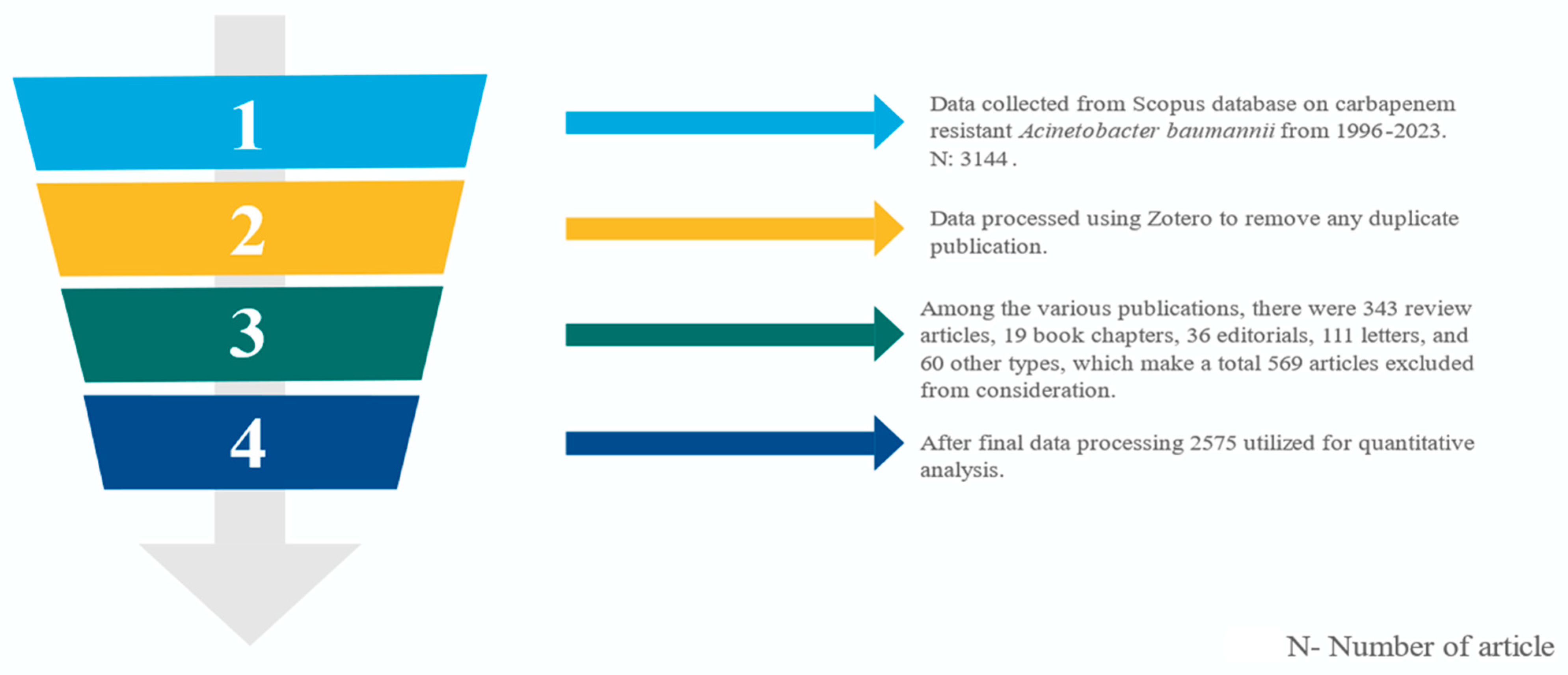
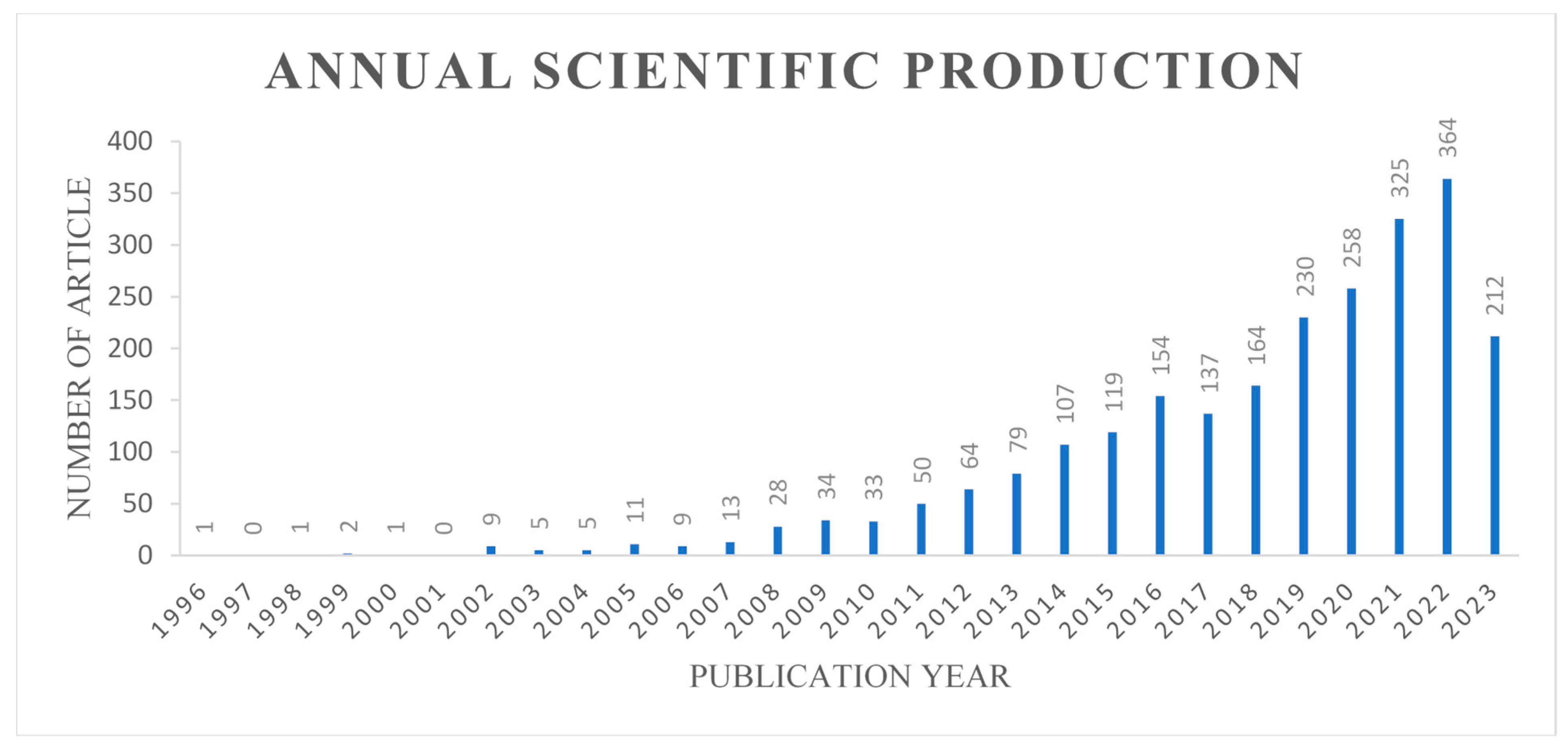
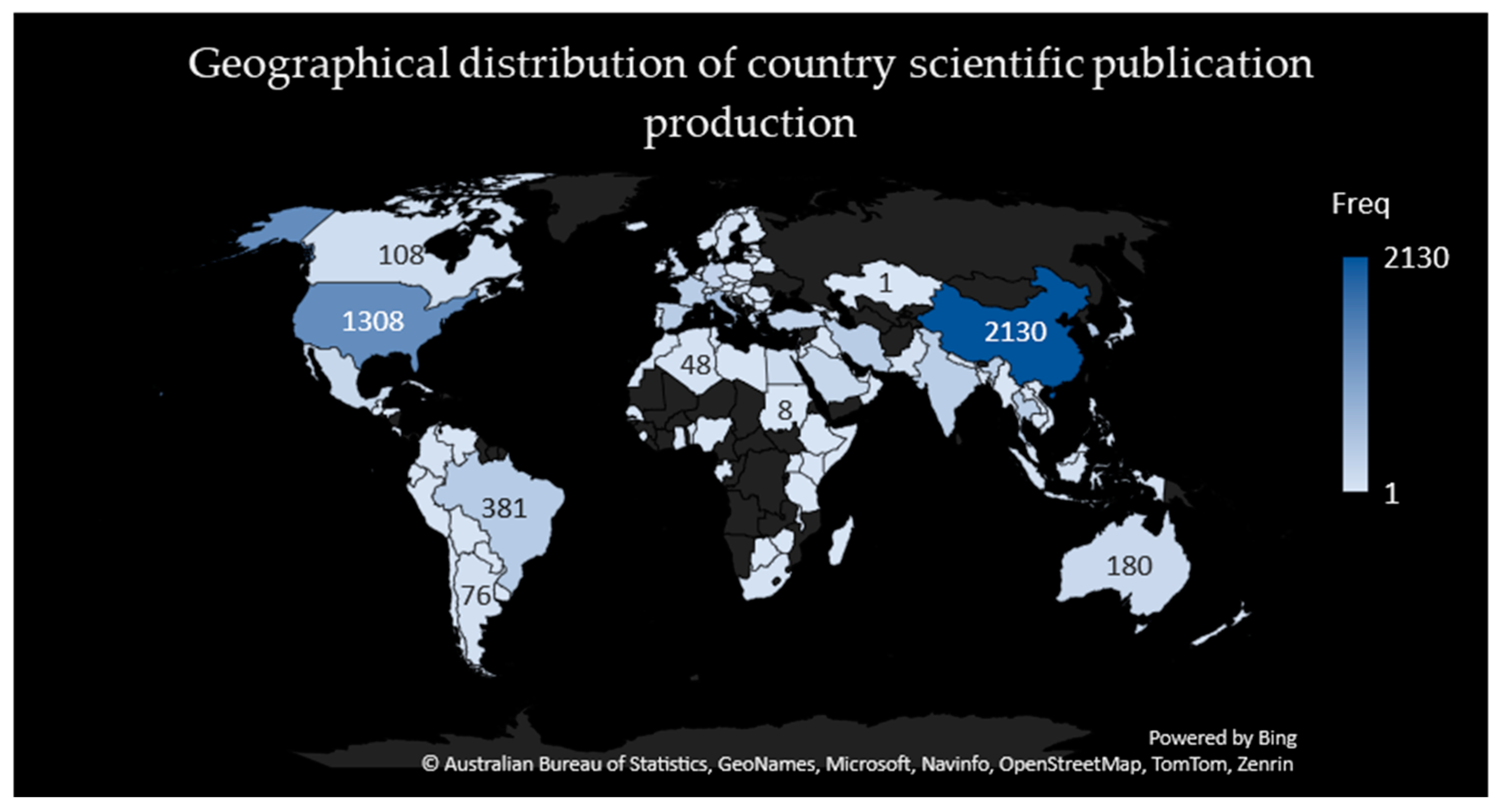
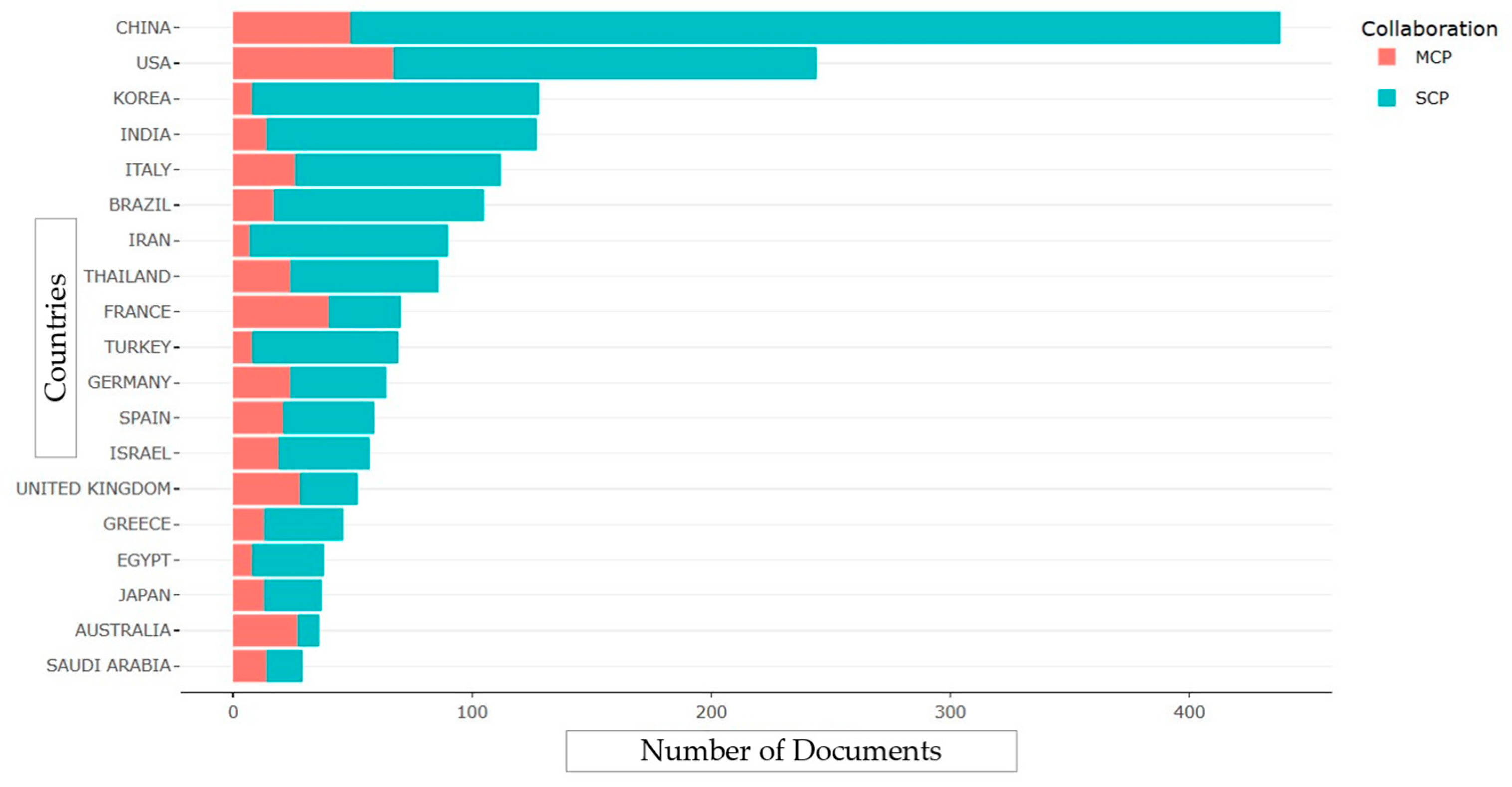
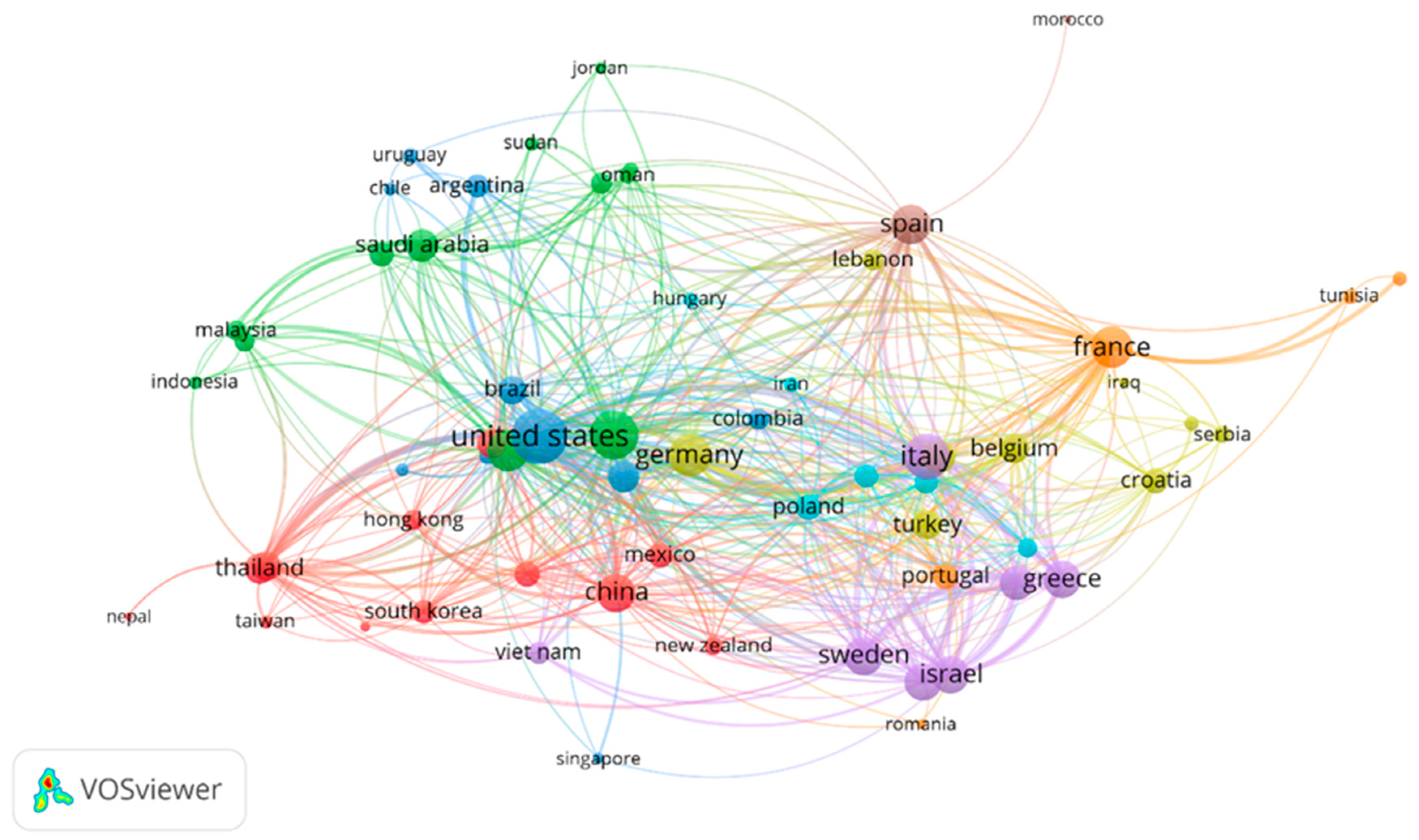
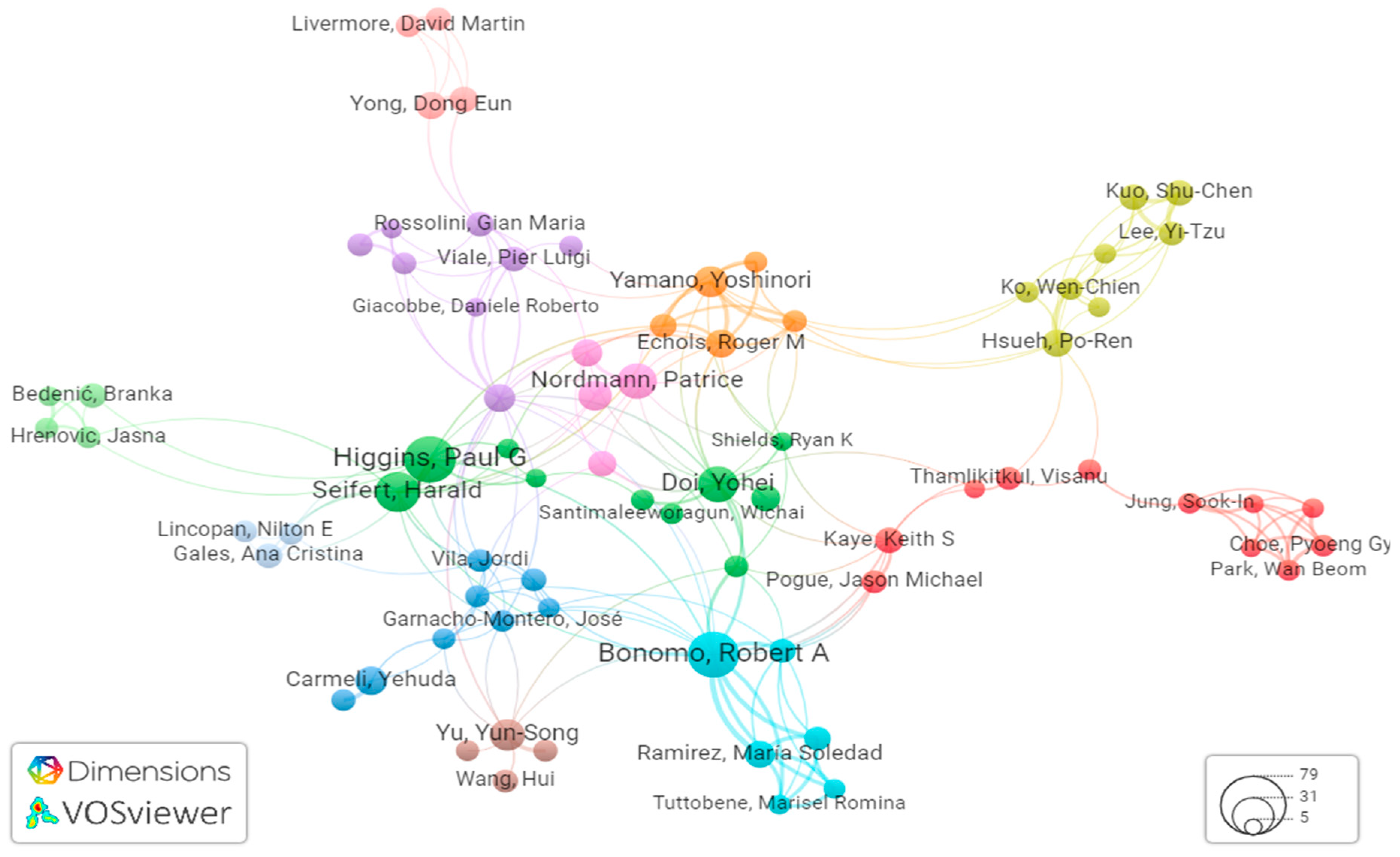

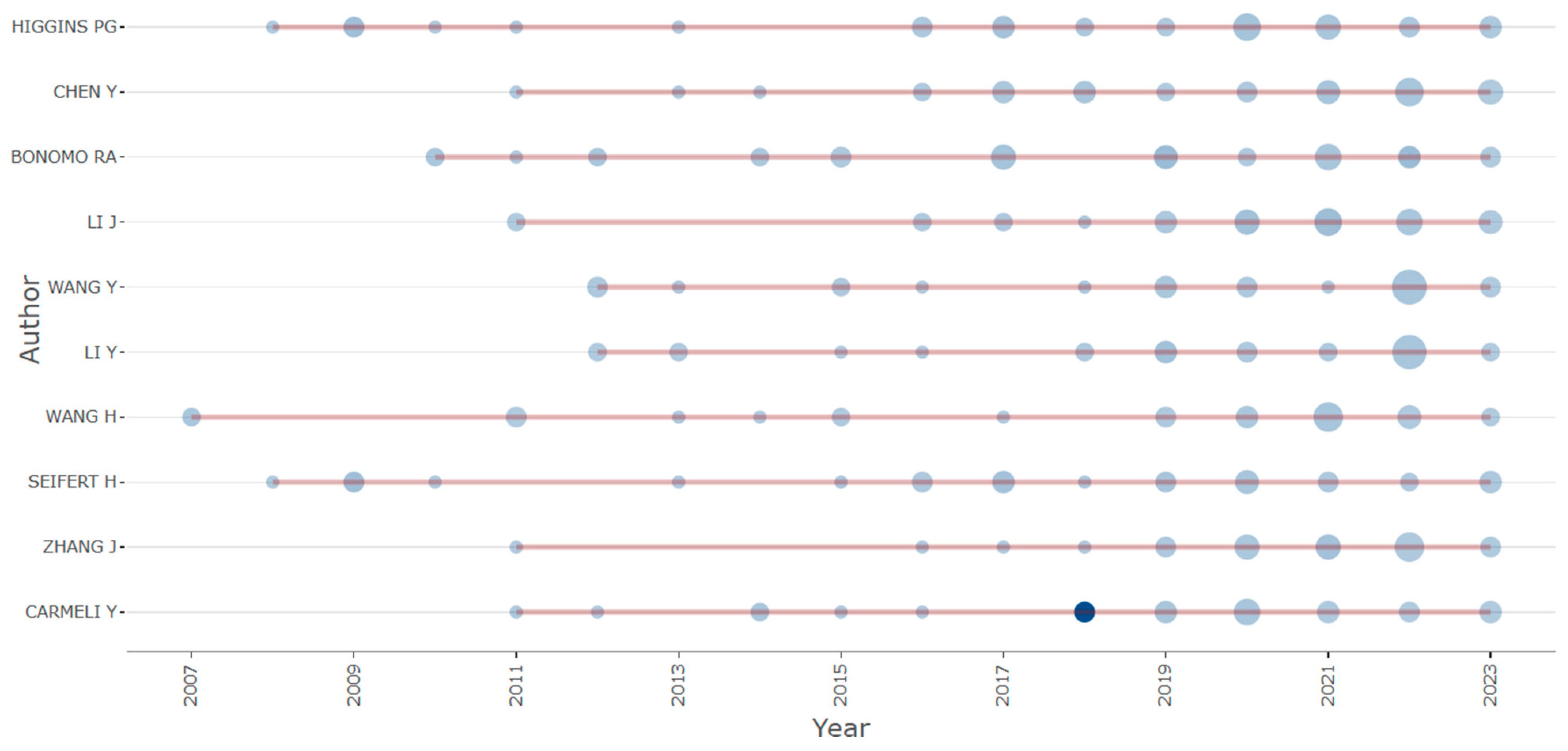
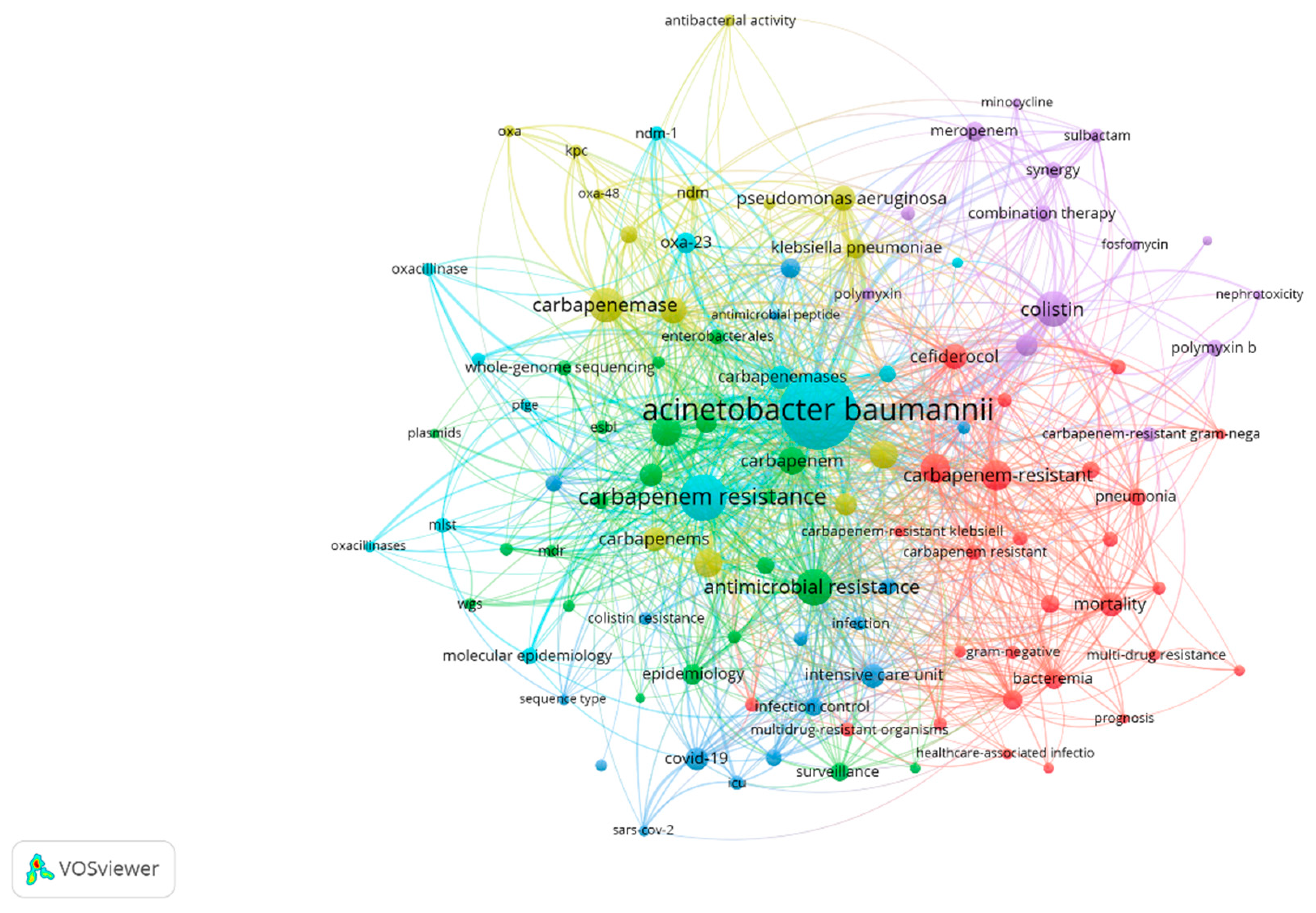
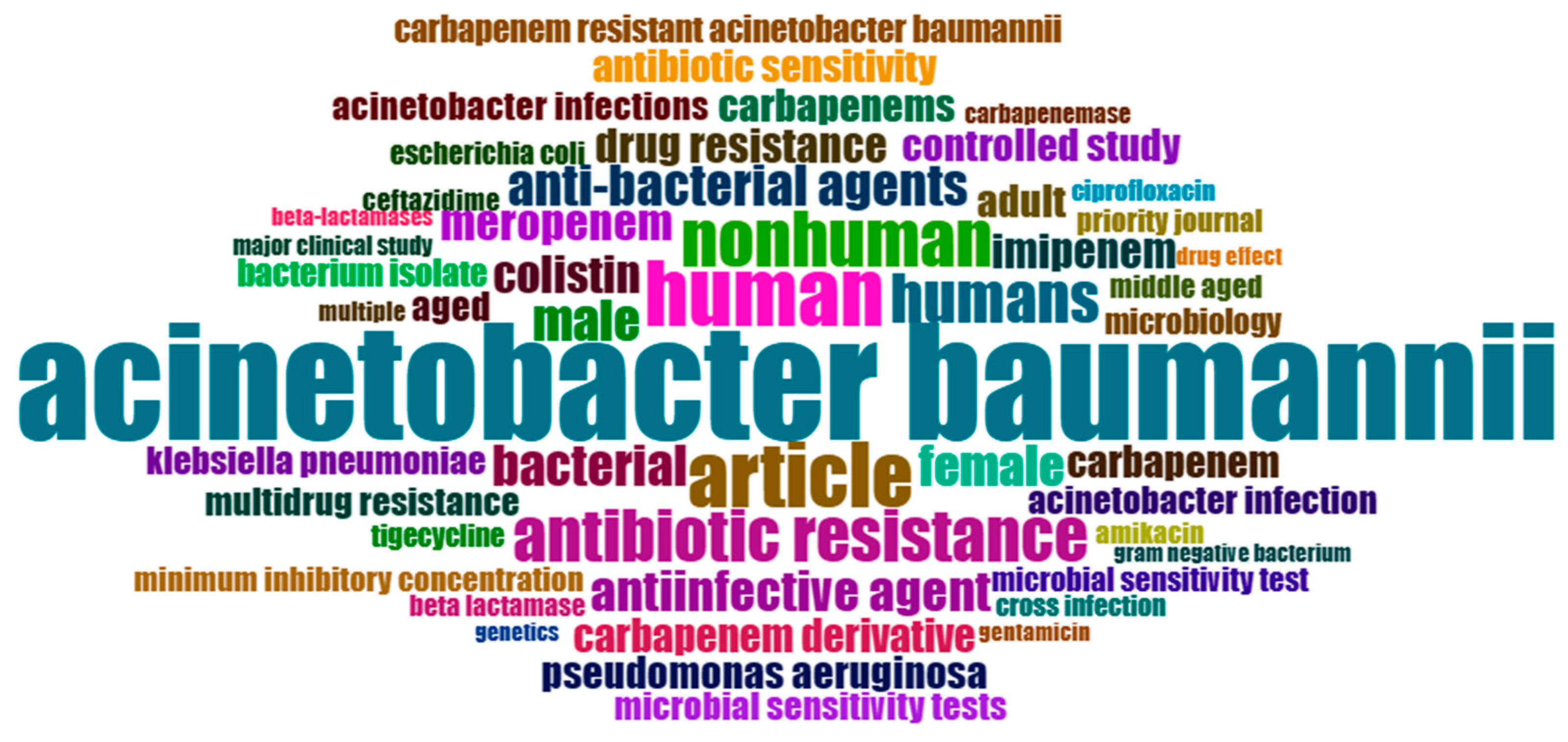
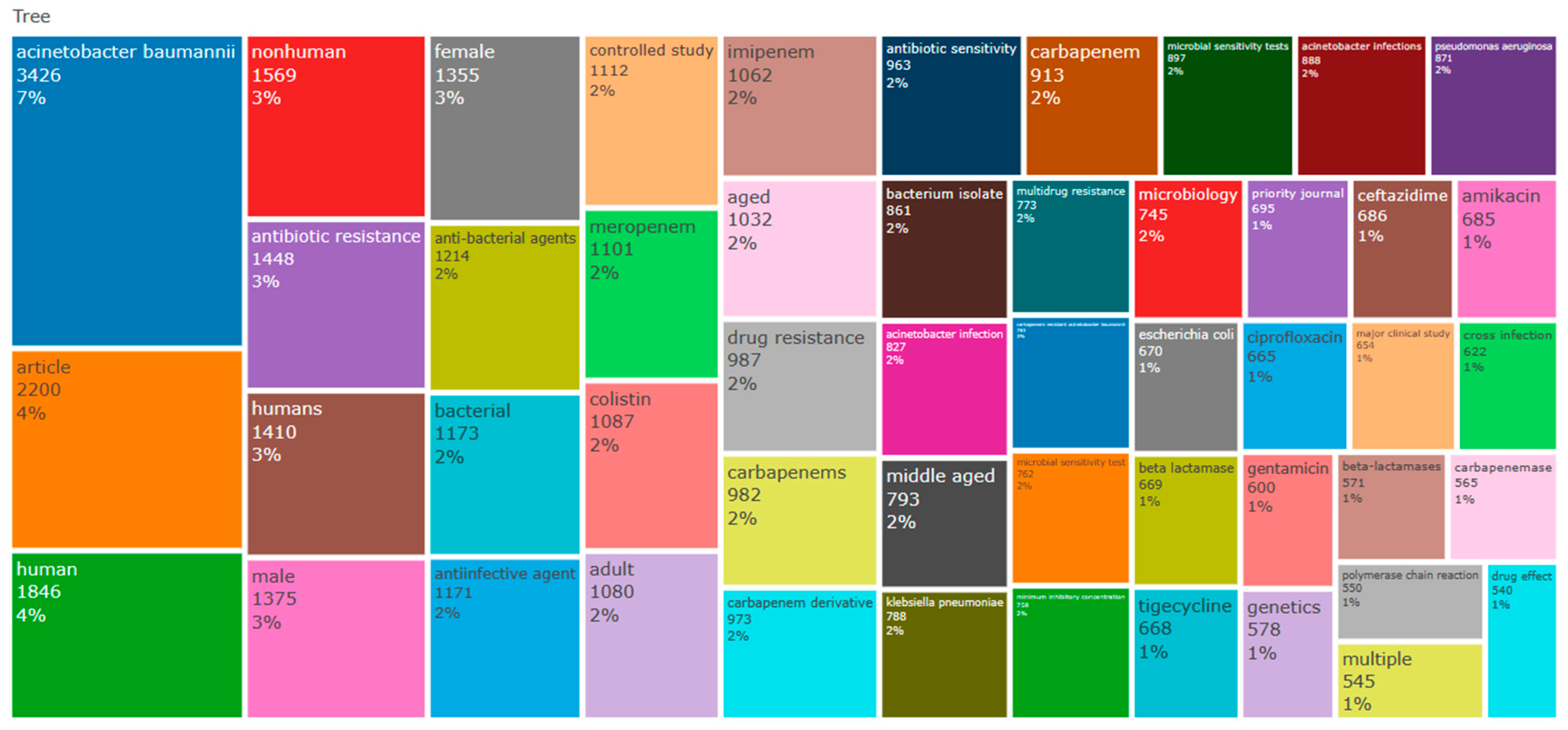
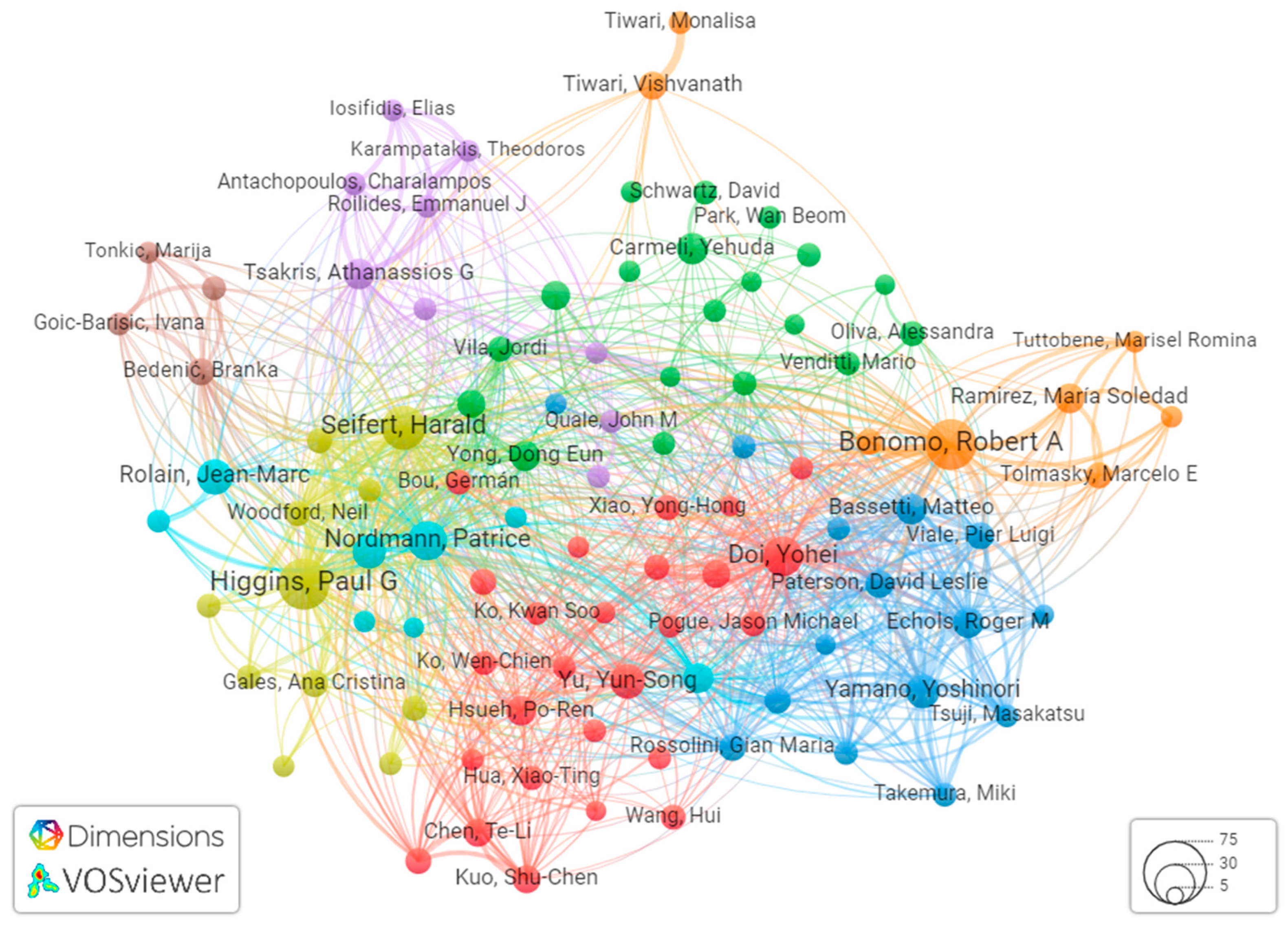
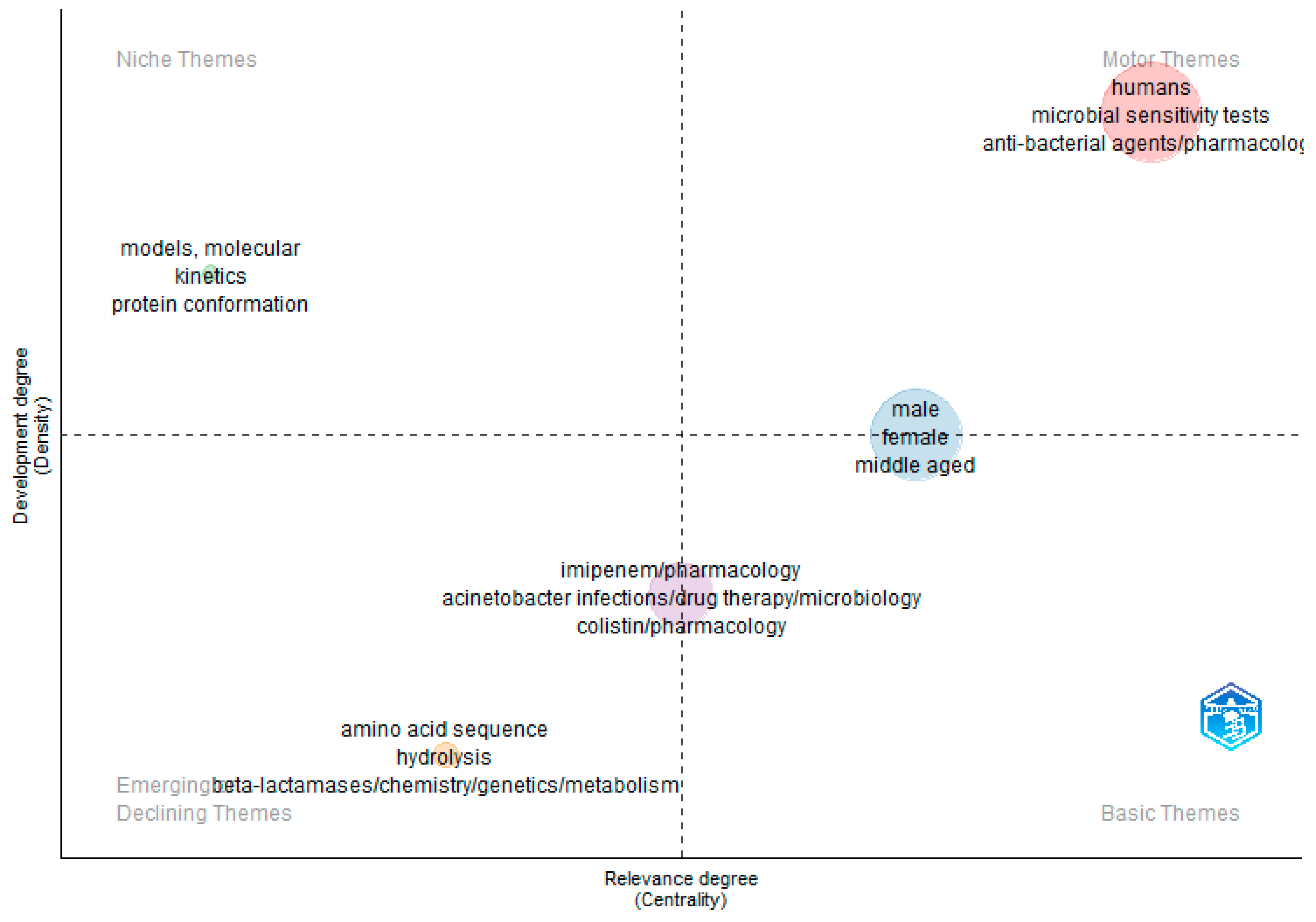
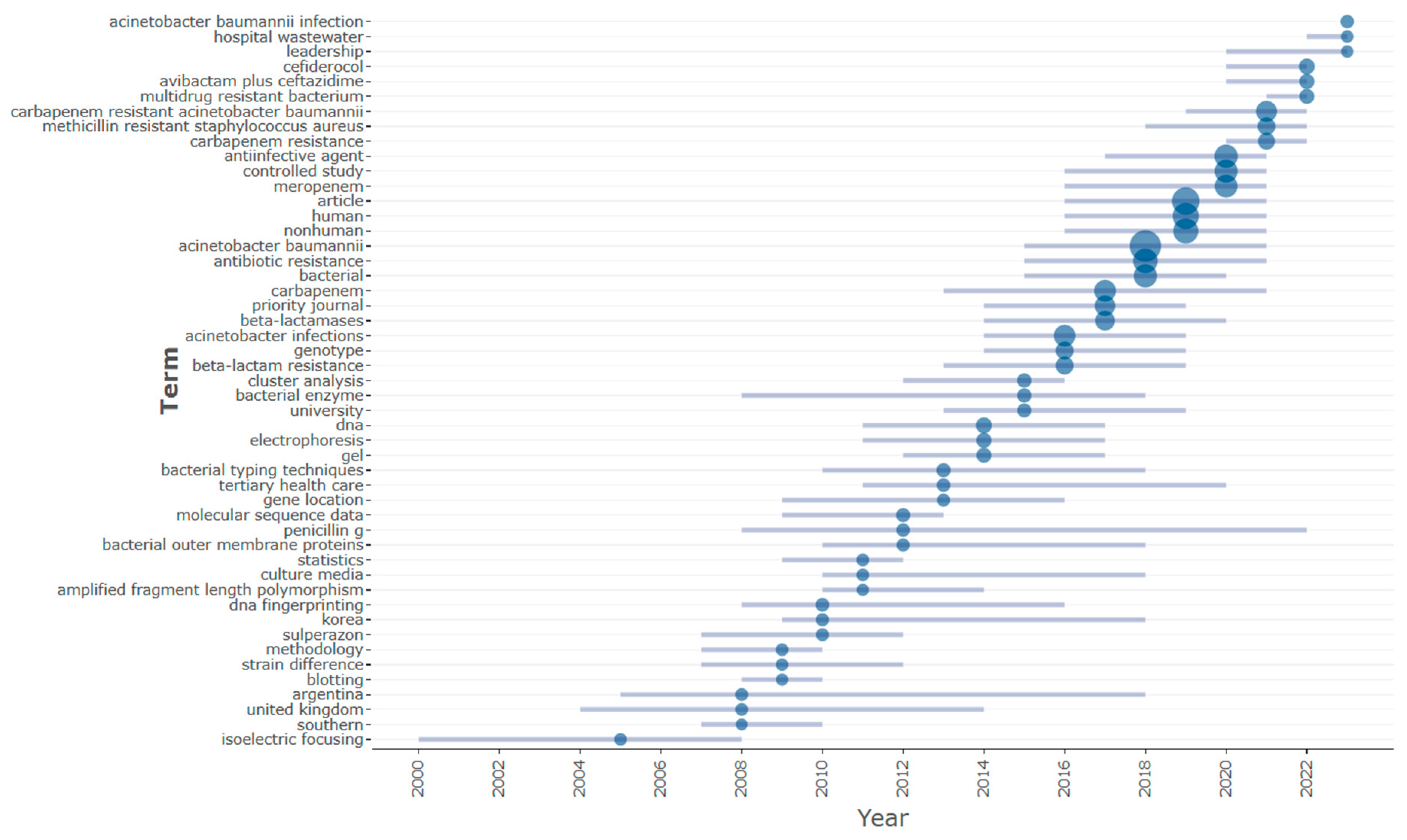
| Data Aspects | Statistical Finding |
|---|---|
| Data Overview | |
| Time Range | 1996 to 2023 |
| Sources (Journals, Books, etc.) | 573 |
| Total Documents | 2415 |
| Average Annual Publication Growth Rate % | 21.94 |
| Average Age of Documents | 4.9 |
| Average Citations per Document | 25.38 |
| Document Contents | |
| Keywords Plus (ID) | 9324 |
| Author’s Provided Keywords (DE) | 3388 |
| Authorship | |
| Total Authors | |
| Authors of Sole-Authored Documents | 24 |
| Authors Collabortion | |
| Sole-Authored Documents | 24 |
| Co-Authors per Document | 8.19 |
| International Co-Authorships % | 24.1 |
| Document Types | |
| Article | 2415 |
| Country | Research Articles | Citations | Total Link Strength (TLS) | |||
|---|---|---|---|---|---|---|
| Number of Research Articles | Rank | Number of Citations | Rank | TLS | Rank | |
| Australia | 56 | 12 | 4555 | 6 | 136 | 5 |
| Austria | 20 | 19 | 3496 | 12 | 86 | 13 |
| China | 334 | 1 | 3996 | 9 | 109 | 9 |
| France | 81 | 8 | 4729 | 5 | 135 | 6 |
| Germany | 101 | 5 | 5238 | 3 | 144 | 4 |
| Greece | 53 | 15 | 1722 | 15 | 104 | 11 |
| India | 126 | 3 | 1786 | 14 | 65 | 16 |
| Israel | 58 | 11 | 4479 | 7 | 102 | 12 |
| Italy | 124 | 4 | 6079 | 2 | 168 | 3 |
| Japan | 54 | 14 | 2511 | 12 | 58 | 18 |
| Netherlands | 31 | 18 | 3761 | 11 | 106 | 10 |
| Saudi Arabia | 55 | 13 | 840 | 18 | 71 | 15 |
| Spain | 75 | 9 | 1901 | 13 | 119 | 7 |
| Sweden | 34 | 16 | 4209 | 8 | 114 | 8 |
| Switzerland | 34 | 17 | 3794 | 10 | 79 | 14 |
| Thailand | 88 | 6 | 986 | 17 | 64 | 17 |
| Turkey | 64 | 10 | 1295 | 16 | 58 | 19 |
| United Kingdom | 85 | 7 | 4852 | 4 | 196 | 2 |
| United States | 311 | 2 | 13,009 | 1 | 281 | 1 |
| Authors | Articles | Articles Fractionalized |
|---|---|---|
| Higgins PG | 39 | 5.76 |
| Bonomo RA | 37 | 4.79 |
| Chen Y | 37 | 3.99 |
| Li J | 36 | 3.56 |
| Wang Y | 35 | 3.63 |
| Li Y | 34 | 3.93 |
| Wang H | 34 | 4.89 |
| Seifert H | 32 | 4.83 |
| Zhang J | 32 | 3.25 |
| Carmeli Y | 31 | 4.04 |
| S No. | Keyword | Occurrence | Total Link Strength |
|---|---|---|---|
| 1 | Acinetobacter baumannii | 532 | 1320 |
| 2 | Carbapenem resistance | 196 | 490 |
| 3 | Antimicrobial resistance | 121 | 277 |
| 4 | Colistin | 115 | 332 |
| 5 | Carbapenemase | 107 | 284 |
| 6 | Carbapenem-resistant | 86 | 233 |
| 7 | Antibiotic resistance | 80 | 187 |
| 8 | Carbapenem-resistant Acinetobacter baumannii | 78 | 155 |
| 9 | Gram-negative bacteria | 72 | 193 |
| 10 | Multidrug resistance | 71 | 198 |
| Title | Journals | Total Citations | Reference |
|---|---|---|---|
| “Discovery, research, and development of new antibiotics: the WHO priority list of antibiotic-resistant bacteria and tuberculosis” | The Lancet Infectious Diseases | 4000 | [23] |
| “Global spread of carbapenem-resistant Acinetobacter baumannii” | Journal of Antimicrobial Chemotherapy | 822 | [24] |
| “Colistin alone versus colistin plus meropenem for treatment of severe infections caused by carbapenem-resistant Gram-negative bacteria: an open-label, randomized controlled trial” | The Lancet Infectious Diseases | 461 | [25] |
| “OXA-143, a Novel Carbapenem-Hydrolyzing Class D β-Lactamase in Acinetobacter baumannii” | Antimicrobial Agents and Chemotherapy | 298 | [26] |
| “Molecular Epidemiology of Clinical Isolates of Carbapenem-Resistant Acinetobacter spp. from Chinese Hospitals” | Antimicrobial Agents and Chemotherapy | 279 | [27] |
| “New Treatment Options against Carbapenem-Resistant Acinetobacter baumannii Infections” | Antimicrobial Agents and Chemotherapy | 266 | [28] |
| “Carbapenem-resistant Acinetobacter baumannii and Klebsiella pneumoniae across a hospital system: impact of post-acute care facilities on dissemination” | Journal of Antimicrobial Chemotherapy | 245 | [29] |
| “Combination therapy for carbapenem-resistant Gram-negative bacteria” | Journal of Antimicrobial Chemotherapy | 247 | [30] |
| “Active and Passive Immunization Protects against Lethal, Extreme Drug Resistant-Acinetobacter baumannii Infection” | PLoS ONE | 195 | [31] |
| “The antimicrobial peptide ZY4 combats multidrug-resistant Pseudomonas aeruginosa and Acinetobacter baumannii infection” | Proceedings of the National Academy of Sciences | 189 | [32] |
| Country | TC | Average Article Citations |
|---|---|---|
| USA | 13,009 | 57.10 |
| CHINA | 6027 | 14.00 |
| GERMANY | 4787 | 74.80 |
| UNITED KINGDOM | 3463 | 67.90 |
| SPAIN | 2760 | 47.60 |
| FRANCE | 2568 | 36.70 |
| KOREA | 2419 | 19.00 |
| ITALY | 2259 | 20.40 |
| INDIA | 2063 | 16.40 |
| ISRAEL | 1778 | 31.20 |
| S No. | Sources | Documents | Impact Factor | Citations |
|---|---|---|---|---|
| 1 | The Lancet Infectious Diseases | 5 | 56.3 | 3734 |
| 2 | Antimicrobial Agents and Chemotherapy | 82 | 4.9 | 2417 |
| 3 | Clinical Infectious Diseases | 34 | 20.9 | 2293 |
| 4 | Frontiers in Microbiology | 61 | 6.06 | 1340 |
| 5 | Journal of Antimicrobial Chemotherapy | 50 | 5.75 | 1269 |
| 6 | Microbial Drug Resistance | 70 | 2.6 | 1138 |
| 7 | International Journal of Antimicrobial Agents | 52 | 15.44 | 964 |
| 8 | Journal of Infectious Diseases | 5 | 7.75 | 938 |
| 9 | Antimicrobial Resistance and Infection Control | 40 | 5.29 | 835 |
| 10 | PLoS ONE | 37 | 3.7 | 818 |
Disclaimer/Publisher’s Note: The statements, opinions and data contained in all publications are solely those of the individual author(s) and contributor(s) and not of MDPI and/or the editor(s). MDPI and/or the editor(s) disclaim responsibility for any injury to people or property resulting from any ideas, methods, instructions or products referred to in the content. |
© 2023 by the authors. Licensee MDPI, Basel, Switzerland. This article is an open access article distributed under the terms and conditions of the Creative Commons Attribution (CC BY) license (https://creativecommons.org/licenses/by/4.0/).
Share and Cite
Jangid, H.; Kumar, D.; Kumar, G.; Kumar, R.; Mamidi, N. Bibliometric Examination of Global Scientific Research about Carbapenem-Resistant Acinetobacter Baumannii (CRAB). Antibiotics 2023, 12, 1593. https://doi.org/10.3390/antibiotics12111593
Jangid H, Kumar D, Kumar G, Kumar R, Mamidi N. Bibliometric Examination of Global Scientific Research about Carbapenem-Resistant Acinetobacter Baumannii (CRAB). Antibiotics. 2023; 12(11):1593. https://doi.org/10.3390/antibiotics12111593
Chicago/Turabian StyleJangid, Himanshu, Deepak Kumar, Gaurav Kumar, Raj Kumar, and Narsimha Mamidi. 2023. "Bibliometric Examination of Global Scientific Research about Carbapenem-Resistant Acinetobacter Baumannii (CRAB)" Antibiotics 12, no. 11: 1593. https://doi.org/10.3390/antibiotics12111593
APA StyleJangid, H., Kumar, D., Kumar, G., Kumar, R., & Mamidi, N. (2023). Bibliometric Examination of Global Scientific Research about Carbapenem-Resistant Acinetobacter Baumannii (CRAB). Antibiotics, 12(11), 1593. https://doi.org/10.3390/antibiotics12111593









